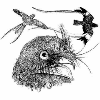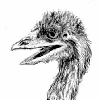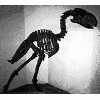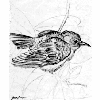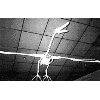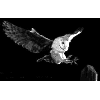NEORNITHES
CLASSIFICATION
Animalia: Vertebrata: Tetrapoda: Sauropsida: Archosauromorpha:
Ornithodira: Dinosauria: Theropoda: Tetanurae: Coelurosauria: Avialae: Ornithurae
CLADOGRAM:
—Neornithes “new birds” =Aves sensu Gauthier, 1986 |–Palaeognathae “old jaws” =Palaeognathia =Eoaves | | INCERTAE SEDIS: | | Eremopezus | | Remiornis | | Stromeria | |?-Eleutherornithidae * | |–Tinamiformes “Tinamus (tinamou) forms” (tinamous) | `–Ratitae =Ratiti | |–Apteryges | | |–Apterygiformes (kiwis) | | |?-Dinornithiformes (moa) * | | `?-Dromornithiformes (mihirung) * | `–Struthiones | |–Aepyornithiformes (elephant birds) * | `–+–Casuariiformes (cassowaries, emus) | `–+–Rheiformes (rheas) | `–Struthioniformes (ostriches) `–Neognathae “new jaws” =Neognathia =Neoaves |–Galloanserae | |?-Anseriformes (ducks, geese, swans, screamers, Presbyornis, Gastornis?) | `?-Galliformes (turkeys, grouse, quails, pheasants, peafowl, etc.) `–+–Mesitornithidae `–+?-Ardeidae (herons) |–Eurypygoidea |–Otides |?-Rhynchoceti |–Gruimorphae | |–Gruiformes (cranes, rails, etc.) | `?-Podicepiformes (grebes) |–Charadriomorphae | |–Graculavidae * | |–Ciconiimorphae | | |–Phoenicopteriformes (flamingos) | | `–+–Ciconiiformes (storks, spoonbills?, New World vultures?, etc.) | | `–+–Pelecaniformes (pelicans, frigate birds, gannets, boobies, cormorants, anhingas, etc.) | | `–+–Procellariformes (albatrosses, petrels, shearwaters, etc.) | | `–+–Gaviiformes (loons) | | `–Sphenisciformes (penguins) | `–+–Burnithidae | `–Charadriiformes | |–“Charadriida” (avocets, etc.) | |?-Phalaropodidae (phalaropes) | |–“Scolopacida” (jacanas, etc.) | |–+–Laridae | | `?-Sternidae | |–+–Stercorariidae | | `–Dromadidae | `–+–Turnicidae (button quails) | `?-+–Pteroclidiformes | `–+–Columbiformes (pigeons, doves, sandgrouse, dodo) | `–Psittaciformes (cockatoos, parrots) `–+–Cariamae (phorusrhacids, etc.) `–+–+?-Falconiformes (falcons, caracaras) | `?-Opisthocomiformes (hoatzins, Foro?) `–+?-Cuculiformes (cuckoos, etc.) `–+?-Pandionidae (ospreys) |?-Sagittariidae (secretary birds) |–+?-Musophagiformes (turacos, etc.) | `?-Accipitriformes (hawks, eagles, Old World vultures, Horusornis?) `–Anomalogonatae | INCERTAE SEDIS: | Zygodactylus |–Coliiformes (mousebirds) |–Sandcoleiformes * |–+–Strigiformes (owls) | `–+–Apodiformes (swifts, hummingbirds) | `–Caprimulgiformes (goatsuckers) `–+–Coraciiformes (rollers, courols, etc.) `–+–Trogoniformes (trogons, todies, motmots, bee eaters, kingfishers, etc.) `–Bucerotimorphae |–Bucerotiformes (hornbills, hoopoes, etc.) `–+–Piciformes (barbets, toucans, woodpeckers, etc.) `–Passeriformes (songbirds, etc.)
ESSAY
| This group contains all modern, toothless birds. They are divided into paleognathans (ratites and tinamous) and neognathans (all other modern birds). Beyond that, classification gets tricky — there are about as many schemes as there are scientists studying avian phylogeny. Neornithean systematics is highly volatile at the moment, so don’t be surprised if you see changes here. SURVIVORS:When all the other dinosaurs died out at the end of the Cretaceous Period, neornithean birds made an attempt to fill the empty niches left by the large predatory theropods. In South America, large, ground-dwelling, carnivorous phorusrhacids evolved and lasted until fairly recently. But today, with few exceptions, birds are aerial, not terrestrial. In the skies, however, these last descendants of the mighty dinosaurs still reign supreme. They beat out pterosaurs in the Mesozoic (in the smaller niches) and today they keep mammalian bats from flying during the day. There are over twice as many living species of bird as living species of mammal. They are the last vestige of the dinosaurs’ dominion. |
